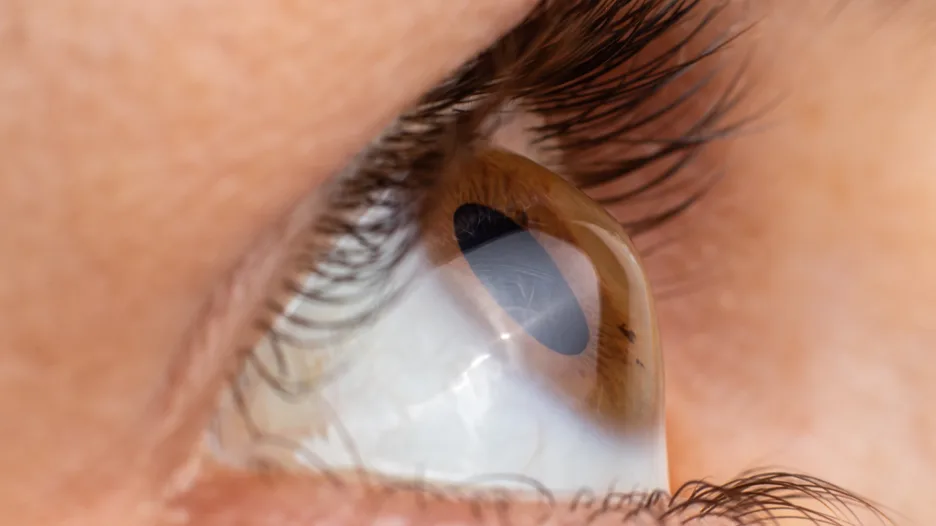Let’s say you’ve been squinting a lot lately. Night driving has become a bit of a nightmare, and reading small print feels like a workout. You book an eye exam, and the optometrist says you have astigmatism. Great—but what does that actually mean?
If you’re in Ontario and have just been diagnosed (or suspect you might have it), this guide will help you make sense of what’s going on. We’ll walk you through what astigmatism really is, how it affects your vision, what causes it, and the ways to correct it—from glasses and contact lenses to more advanced options. No fluff, just clear, straightforward answers from the team at LMC Optometry & Eye Care.
What Is Astigmatism?
Astigmatism is a common eye condition that causes blurred or distorted vision. It happens when the shape of your cornea—or sometimes your lens—isn’t perfectly round. Instead of being shaped like a basketball, it’s more like a football. That uneven curve bends light unevenly, so it can’t focus clearly on the retina at the back of your eye.
In plain English? Things look blurry. Straight lines may appear tilted. Your eyes might feel tired even after a short time reading, and focusing might seem harder than it should be.
Astigmatism Symptoms
You might have astigmatism and not even know it. Many people chalk up their symptoms to just needing “stronger glasses,” but astigmatism has a few telltale signs:
- Blurry or fuzzy vision, near or far
- Eyestrain or fatigue after reading or screen time
- Headaches—especially around your eyes or forehead
- Trouble seeing clearly at night
- Squinting often to bring things into focus
- Halos or glare around lights, especially when driving
If any of these sound familiar, it’s worth booking an eye exam for astigmatism.
What Causes Astigmatism?
Most cases are inherited—you’re simply born with a curved cornea. But it can also develop over time or after:
- Eye injuries or surgery
- Keratoconus (a condition where the cornea thins and bulges out)
- Changes with age or chronic eye rubbing
It doesn’t mean anything’s wrong with you—it’s just how your eyes are shaped.
Types of Astigmatism
There are a few different forms, and knowing which one you have helps shape your treatment:
- Corneal Astigmatism: The cornea is the issue. This is the most common type.
- Lenticular Astigmatism: The lens inside your eye has an irregular shape.
- Regular Astigmatism: The eye curves more in one direction than the other. Easier to correct.
- Irregular Astigmatism: The curve isn’t consistent. Often linked to injury or keratoconus, and may need specialty lenses.
How Is Astigmatism Diagnosed?

The best way to find out is with a comprehensive eye exam. At LMC Optometry & Eye Care, our optometrists use a mix of tests, like a keratometer to measure the curve of your cornea, or a refraction test to figure out your exact prescription.
The whole process is quick and painless. Many people are surprised to learn they’ve had mild astigmatism for years and just thought their eyes were “tired.”
Can Astigmatism Be Cured?
Let’s clear this up: astigmatism isn’t a disease, and there’s no “cure” in the traditional sense. But it can be effectively treated and managed with the right correction.
Here’s how.
1. Glasses
The simplest fix. Glasses for astigmatism use lenses that counter the uneven curve of your eye, allowing light to hit your retina properly. They’re great for everyday wear and come in tons of stylish options.
2. Contact Lenses for Astigmatism
Toric lenses are specially shaped to correct astigmatism and stay aligned in your eye. They’re available in soft, rigid gas-permeable, and hybrid varieties. The right fit is key—our team at LMC can help find what works best.
3. Orthokeratology (Ortho-K)
These are specially designed rigid contacts worn overnight to gently reshape the cornea. You remove them in the morning and enjoy clear vision all day, without glasses or daytime contacts.
Great for mild to moderate cases and people who don’t want to wear anything during the day.
4. Refractive Surgery
Procedures like LASIK or PRK reshape the cornea permanently. Not everyone is a candidate, but many with regular astigmatism see excellent results.
We don’t perform surgery at LMC Optometry & Eye Care, but we do refer to trusted surgeons and help with all pre- and post-op care.
How to Fix Astigmatism Naturally
There’s no natural “fix” for astigmatism. You can’t train your eye to reshape itself. But that doesn’t mean you’re powerless. Here’s what can help:
- Stick to your vision correction plan (glasses or contacts)
- Avoid excessive eye rubbing
- Follow a balanced diet rich in eye-supporting nutrients
- Schedule regular eye exams to catch changes early
Do You Need an Eye Exam for Astigmatism?
Absolutely. Especially if it’s been over a year or you’re noticing vision changes. At LMC Optometry & Eye Care, we offer detailed exams that can confirm if astigmatism is present and walk you through every option.
If you’re in Ontario and wondering whether blurred vision is something to worry about, book an exam with our team. You’ll get honest, personalized care from folks who really care about helping you see your best.
Final Thoughts
Astigmatism can feel confusing at first, but once you understand it, it’s surprisingly manageable. Whether you’re noticing blurry night vision, reading fatigue, or headaches after screen time, an eye exam can provide clarity (literally and figuratively).
At LMC Optometry & Eye Care, we’re here to answer your questions, explain your options, and make sure you feel confident about your vision plan.
Ready to See Clearly?
Astigmatism is manageable, and an eye exam is the first step. Book your appointment with LMC Optometry & Eye Care today to start your journey toward clear, comfortable vision. Don’t wait—your best vision is just an exam away!



